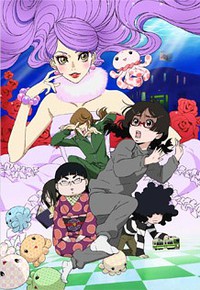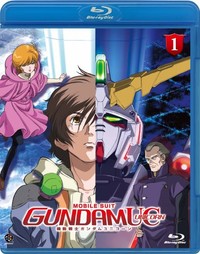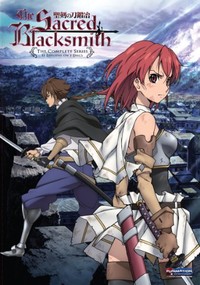Shelf Life
The Last Unicorn
by Erin Finnegan,

Mobile Suit Gundam UC Volume 1: Day of the Unicorn BD
Stream Worthy
Princess Jellyfish ep. 1-11
Rental Shelf
Sacred Blacksmith Complete Series DVD
Perishable
None this week
Nodame ran in the josei manga magazine Kiss. Being in the josei demographic myself, I am an easy target for such stories. Unfortunately, hardly any josei manga reaches our shores. I have even been to under-attended josei panels at conventions.
Princess Jellyfish also ran in Kiss, and it had me hooked from the opening credits (which consists of film parody scenes).
 Based on the thumbnail art and title, I assumed Princess Jellyfish was a magical girl show for otaku. I couldn't have been more wrong, and I've never been so delighted to be wrong about something.
Based on the thumbnail art and title, I assumed Princess Jellyfish was a magical girl show for otaku. I couldn't have been more wrong, and I've never been so delighted to be wrong about something.20-year-old Tsukimi moved to Tokyo with dreams of becoming an illustrator. She lives in an old Japanese-style apartment house where all her housemates are 30-something female otaku (in the Japanese meaning of the word). That is to say, they each have a specialization: Tsukimi herself is a jellyfish otaku, she draws them and visits aquariums frequently; Banba is a train otaku; Chieko collects Japanese dolls and makes kimono; the reclusive Jiji-sama is obsessed with old men and butler cafes; and spaztastic Mayaya is obsessed with Romance of the Three Kingdoms (or possibly Record of the Three Kingdoms). Tsukimi's housemates work numerous part time jobs, one of which is assisting an unseen completely nocturnal manga-ka who also lives in the building.
The character designs are drawn with a deft eye towards girl nerds. Rarely in anime do we see such variation in the female figure, such unattractive curve-less bodies, such horrible hairstyles, or so many un-plucked eyebrows. Strangely enough, I would totally buy figures of these characters, even if they were just wearing their sweats (which they do quite often).
I think Japanese comedies often live or die on the strength of reaction shots. The shocked expression of befuddled characters can make or break the show, depending how it's handled. In Princess Jellyfish, the otaku instinctively turn to stone when confronted with something embarrassing – or whenever they're confronted directly, as they fear confrontation. It's hilarious every time (and probably saves some animation costs besides).
Tsukimi isn't aware of it, but she winds up in a love triangle between two rich brothers who live nearby. Sons of a prominent politician, Shū is a 30-year-old virgin and career politician while his younger brother Kuranosuke cross-dresses almost constantly. Like in Kimi No Todoke, everyone is either too sweet to realize they're in love or too awkward to admit it. Two boys competing for the love of one girl is an old story, but Princess Jellyfish makes it feel fresh and new. Plus, when Tsukimi isn't playing opossum, she reacts to situations with a lot of emotion, drawn in a hilarious way.
As Kuranosuke (dressed as a girl) invades the apartment building (affectionately nicknamed “the Nunnery,” with posted signs which read "no men allowed") to forcibly befriend Tsukimi, the most important thing about him to the roommates is not his social class or family background, but rather, the fact that he is a “Stylish”. Kuranosuke's obsession with fashion eventually leads the series in a Paradise Kiss direction. If you cross-bred Genshiken with Paradise Kiss, you might get this show. Kuranosuke's interaction with the “Nuns” is a lot like Saki's role in Genshiken.
Inevitably, Kuranosuke does some nerd makeovers, but fortunately the series never gets too preachy about it. If anything, Princess Jellyfish has an important message for the socially awkward. The clothes you wear say a lot about you to the people around you, whether or not you want it to happen, and regardless of your investment in your appearance (or lack thereof). Redevelopment in the neighborhood threatens the Nunnery, and what the housemates wear to neighborhood meetings proves to be important to the plot.
This is totally a chick flick (in a good way), as in nearly every episode the characters gather together to eat upscale desserts or share a hot pot of nabe or yakiniku. “Food tastes better if you eat it together,” the characters say. It so happens I'm biased towards culinary manga (from Kitchen Princess to Toriko).
I'm also biased towards unicorns, and there is also a brief appearance by a combination unicorn-pegasus. Basically I'll watch anything with “unicorn” in the title. [TOP]
Gundam Unicorn did not disappoint.
 One huge stumbling block to watching any Gundam show, besides the long history, is that the series doesn't always start off with a succinct explanation of the “UC” timeline. “UC” in this instance refers to the “Universal Century,” a space-faring time period after A.D. (Anno Domini) announced by Earth's leaders. Gundam Unicorn begins with an explanation of UC, as well as some other important Gundam universe facts. Even better, the way this exposition is included is exceptionally well done.
One huge stumbling block to watching any Gundam show, besides the long history, is that the series doesn't always start off with a succinct explanation of the “UC” timeline. “UC” in this instance refers to the “Universal Century,” a space-faring time period after A.D. (Anno Domini) announced by Earth's leaders. Gundam Unicorn begins with an explanation of UC, as well as some other important Gundam universe facts. Even better, the way this exposition is included is exceptionally well done. I recently reviewed some discs of Gundam 00 and complained that there were too many characters. Perhaps because Gundam Unicorn is doled out in hour-long segments, the character number has been kept to a digestible level (or at least in Part One it is reasonable). We primarily follow Banagher Links, a young man at Industrial Seven College who literally leaps out of a school field trip when he sees a girl falling from the sky. (In a space colony... but you get the gist of it. She's more or less floating "downwards.") Anyhow, he reacts like an action hero and steals a ship to save her. We don't know why Banagher has such great reflexes, and neither, seemingly, does he. He just follows his instincts to do the right thing, which is certainly heroic.
This being Gundam and all, war is nigh. The girl, Audrey, knows something that might prevent it if she can get to the right place in time to deliver her message. She seems reluctant to accept Banagher's help, for mysterious reasons.
My Little Pony fans might (like myself) be wondering at this point if “unicorn” is just some kind of a codeword, or if unicorns appear in this show. Rest assured there is indeed a Gundam with a horn (unfortunately, it is not shaped like a horse, or a narwhal). But the historic unicorn tapestry makes an appearance in a classy way.
The visuals are absolutely stunning. The backgrounds are particularly well rendered and give the feeling of a vast ring-shaped space colony. All of the ships and space stations are bustling with activity and covered in little details, which adds a very realistic ambiance, as if space colonies truly are humanity's future. The battle animation is very slick and well-done. If it weren't cut together for a coherent narrative, I'd swear that this was the studio's demo reel to attract clients (that's a high compliment).
The dub is solid, with Steve Cannon giving an admirable emotional performance as Banagher. I like that you have the option of watching this subbed in French, Spanish, or Chinese, not because I'm trying to practice my French, but because I'd like to see home media move towards a world market. Subs in so many languages acknowledges that the audience for Gundam Unicorn is the entire world. (It's like we're moving towards the Universal Century!)
Admittedly I didn't get the "Blu-ray Live" features to work yet. Maybe I'll have better luck with Part Two.
Since this is a Gundam series (or OVA) you can share with non-fans, it seems worthwhile to own it. The retail price is a little steep for a one-hour show, but because the animation is feature quality, I think you're nearly getting your money's worth. I wasn't bothered by the length. I'm getting sick of series that artificially cram an adaptation into 12 or 26 episodes when it doesn't really fit that production pipeline. Plus, this is the sort of thing I'd re-watch without feeling like it was a major commitment.[TOP]
Next I watched The Sacred Blacksmith, which also had solid visuals, but ultimately proved to be disappointing.
 Man, this should've been a much better show. The animation is quite good, the character designs are nice, and the series is short and digestible at just twelve episodes and three distinct story arcs. This ought to appeal to general fans of sword and sorcery fantasy, if it weren't for a couple of severely irritating flaws.
Man, this should've been a much better show. The animation is quite good, the character designs are nice, and the series is short and digestible at just twelve episodes and three distinct story arcs. This ought to appeal to general fans of sword and sorcery fantasy, if it weren't for a couple of severely irritating flaws.First, far too much screen time is devoted to discussing the main character's breast size. Cecily is a female knight, and the sole heir to the Campbell House. It's her first day on the job when, after failing to arrest a crazed warrior in the marketplace, she is saved by a mysterious magical blacksmith with a dark past and a love of katanas. Generic magical Renaissance-ish-Europe plus magical katana forging ought to be a win for nerds in the audience, but Cecily is holding this show back by being a clumsy knight with an alignment so good she doesn't want to kill anyone (worse than a paladin– also sometimes called "Lawful Stupid"). Essentially she's a conscientious objector in a military position. I took this as an otaku database sort of trait; she has to be “pure” in order to be true masturbatory material. In America, you'd sell more dolls of Cecily if she were like Xena the Warrior Princess. Fortunately, Cecily gets an over-powered magic sword to help her out. Unfortunately, I think Cecily misses a lot of chances to be badass in battle (though her skills do develop over the course of the series).
The second problem with this show is surprisingly not that it is harem-like, although that much is true. An array of girls show up in the second arc, including a twin-tails princess of disagreeable temperament (just in case that's your type). Twin-tails and her three foxy retainers all end up living at the Campbell House, but they eat lunch every day with the blacksmith. Did I mention the blacksmith has a young, elf-looking servant girl named LiSA who also has a crush on him? Regardless of LiSA's age, that isn't my problem with The Sacred Blacksmith. My problem is that the action stops dead once per episode while the characters enjoy a meal together. As we learned from Princess Jellyfish (and indeed, Summer Wars), food tastes better if you eat it together. These dinner/lunch/whatever meal scenes would bother me less in a standard harem comedy, wherein the homemaker stereotype invariably feeds the dozens of female lodgers delicious food. It bothered me a lot in this show, where I wanted to see more awesome monster fighting action.
The existing monster fights are very cool; they fight zombies and even a freakin' karkadan. More like that, please! Instead, we get loads of dinner sequences. Inversely, I wouldn't have minded if the show was like Oishinbo and the characters taught us something about historical European cooking.
Getting back to what Sacred Blacksmith does right; the swords are all meticulously well researched. The “three handed” sword is drawn correctly and wielded correctly. In this show, a claymore is really a claymore. Cecily's magic sword is a rapier that also takes on human form as a girl named Aria. Aria's character design looks appropriate for her sword type, which made me think of moe anthropomorphism - in a good way. Again, the nerds in the audience ought to appreciate these fine details. The packaging, on the other hand, plays up the girly aspects of the show, like the inevitable episode where the protagonists are all forced to dress as maids.
At the very least, the blacksmith is reasonably cute, despite his rat tail haircut. The series is careful to include loads of square-jawed manly knights, even if most of them are jerks.
Frankly I'd like to see a re-cut of this show with the ridiculous elements removed and the cool stuff left in. Of course, my definition of cool may be different from yours…[TOP]
By the way, I usually don't use "nerd" in a pejorative sense. I consider nerds, dorks, geeks, and so forth a culture that I participate in and identify with. I know everyone has their own little definition of each one, but at some point your Venn Diagram probably includes all three overlapping somehow.
Gundam geeks can look forward to next week, when I'll review Gundam Unicorn part 2!

This week's shelves come via Andrew from Nashville, TN:
"My name is Andrew and I have been collecting DVDs since late 2001. I worked at Blockbuster for all four years of high school and thats when most of my collection was built. I own around 26 anime series/movie DVDs along with a bunch of live action movies/TV series. I owned more but when i needed money to get through college a lot of my collection was sold. I now have a full time job and am working on catching up on anime I missed. "



Nice!
Want to show off your stuff? Send your jpgs to [email protected]. Thanks!
discuss this in the forum (102 posts) |
this article has been modified since it was originally posted; see change history